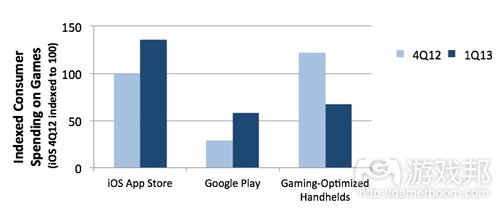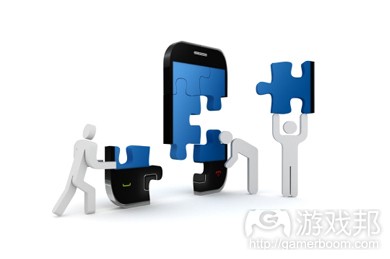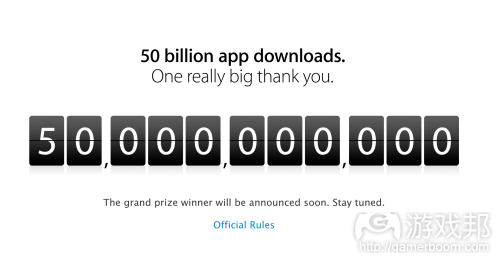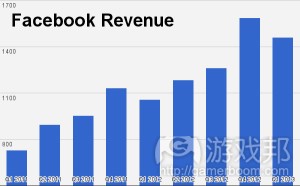每日观察:关注美国付费玩家对移动游戏的投入(5.18)
1)IDC与App Annie最新数据显示,2013年第一季度用户在iOS游戏的总投入超过了在专属掌机游戏上的开支。
报告指出,用户对盒装游戏的消费额下降,部分要归咎于季节性原因,即传统的假期后投入下降因素。
而NPD报告指显示,2013年第一季度3DS软件销售实际上同比去年增长52%(这是任天堂第一方游戏的销售情况),该时期任天堂在美国的第一方3DS软件销量超过210万份。
2012年任天堂3DS第一方软件历时30周才实现200万销量,而在2013年仅历时18周就创造了同样的成绩。
2)SuperData Research最新数据显示,美国付费玩家每月在移动游戏上的投入已超越以往水平,4月份平均每名移动付费玩家月消费额首次突破12美元。
Mobage游戏《Marvel:War of Heroes》取代EA游戏《The Simpsons:Tapped Out》进入4月份游戏收益前三甲,King游戏《Candy Crush Saga》也取代Supercell作品《Clash of Clans》看似不可撼动的位置。
而社交游戏领域尽管流失了270万月活跃用户,其月付费用户平均收益却增长至33美元。
3)Vanson Bourne最近针对9个国家/地区的590名企业首席信息官(CIO)与IT主管的调查结果显示,这些群体并不是很看好公司的移动业务。
这些受访者表示,他们平均5个月才更新一次应用,他们无法紧跟移动设备制造商的步伐,持续推出更新版本的软件。
三分之一受访者称公司的移动开发团队效率偏低,79%称团队推同的移动业务是公司内部与第三方支持的成果。
有78%主机公司的CIO表示,公司的计算机系统难以制作应用来支持自己的技术,86%表示移动应用开发者不愿意与主机公司合作。
Android平台最受这一群体欢迎,有78%公司针对这一平台开发应用,iOS平台支持率也达到65%,Windows Phone支持率为52%。
4)据pocketgamer报道,苹果日前正式宣布App Store上线58个月以来已实现500亿次下载量,平均每月下载量达20亿次,平均每秒下载量为800次。
谷歌也在最近的Google I/O大会上宣布Google Play应用下载量已达480亿次,上个月下载量为25亿次。
5)据venturebeat报道,Facebook最近股价稳定居于25美元左右,比IPO时下降了30%左右(IPO时曾高达每股40美元)。
但从Facebook最近财报表现来看,该公司似乎正在恢复元气,2013年第一季度时的收益为14.6亿美元(去年同期仅为10亿美元),移动平台占其所有广告收益的30%,Facebook已占据全美6.5%的在线广告收益。
目前舆论一致看好Facebook股价,多数分析师认为Facebook股票评级为强势买入,极少人给予弱于大盘的评价。
6)据insidemobileapps报道,Google Play商务及盈利产品经理Ibrahim Elbouchikhi日前表示,从2012年5月至2013年4月,Google Play应用内置收益增长了700%;自推出订阅服务以来,应用收益每季度都翻倍增长。
在过去12个月中,Android平板电脑的应用购买率比智能手机用户高1.7倍,较新的Android版本的应用购买率也比旧版本高2.2倍;平均每用户收益也比去年增长2.5倍。星级评价越高的应用,盈利性也相对更高。
Google Play游戏业务开发主管Bob Meese指出,该平台多数高营收应用采用了免费增值模式(除了《Minecraft-Pocket Edition》之外)。(本文为游戏邦/gamerboom.com编译,拒绝任何不保留版权的转载,如需转载请联系:游戏邦)
1)Gamers now spending more on iOS games than handhelds
by Matthew Diener
On the heels of SuperData Research’s findings that paying mobile gamers in the US are now spending more than ever, new data suggest that they’re outpacing gaming handheld spending as well.
A joint study by IDC and App Annie reports that the total spending on iOS games exceeded the amount spent on dedicated handheld games in the first quarter of 2013.
Going down
The study’s findings appear to paint a rather grim picture for gaming-optimised handhelds, depicting a dramatic drop between Q4 2012 and Q1 2013.
However, the report’s authors note that the “significant decreases in consumer spending and packaged game shipments” for handhelds is due – in part – to “seasonality”, pointing to the traditional post-holiday spending slump.
Indeed, 3DS software sales are actually up 52 percent year on year according to numbers published by NPD – although these numbers refer only to first-party Nintendo releases.
Story of two halves
“Through the first four months of the year, Nintendo has already sold more than 2.1 million units of first-party Nintendo 3DS software in the US alone, an increase of 52 percent over the same time period last year,” noted NPD in a statement.
“In 2012, it took 30 weeks for Nintendo 3DS to sell 2 million units of first-party software. In 2013, the platform accomplished that same feat in 18 weeks.”
Though slow PS Vita game sales are likely to drag overall handheld game sales down, it appears there’s life in the market yet, even if smartphone games are now the portable sector’s dominant force.(source:pocketgamer)
2)Paying off: Paying mobile gamers in US now spending more than ever
by Matthew Diener
Paying players in the US now spend more on mobile games every month than they ever have done in the industry’s history.
That’s according to SuperData Research, which – in its most recent data – notes that, while overall spending on mobile fell across the month of April, the average amount individual paying gamers are spending broke through the $12 barrier for the first time.
Free for all
Said milestone, of course, only really matters to the game’s that directly benefited from this apparent spending spree.
Mobage’s Marvel: War of Heroes broke into the top three grossing titles for the month, replacing EA’s tongue-in-cheek city builder The Simpsons: Tapped Out.
The Simpsons: Tapped Out
King’s Candy Crush Saga also finally managed to displace Supercell’s seemingly unstoppable Clash of Clans.
Elsewhere, the social games category followed a similar trajectory to the mobile games market. Despite a continued decrease in spending and a loss of a reported 2.7 million monthly active users, the average revenue per monthly paying players for social games actually increased to $33.(source:pocketgamer)
3)A third of businesses say their mobile services are sluggish
by Zen Terrelonge
Takes around five months to create new versions of apps.
Micro Focus’ software optimisation firm Borland enlisted Vanson Bourne to survey 590 chief information officers and IT directors across nine countries and finds that they’re less than impressed with their mobile operations.
It takes an average of five months to deliver new versions of apps to support mobile device updates, and respondents say that they can’t keep up with OEMs continually rolling out updated software.
A third believe the mobile development team is sluggish and outpaced, with 79 per cent confirming that the team delivering mobile is a mixture of in-house and third party support.
Date shows that mainframe organisations suffer, as 78 per cent of CIOs for mainframe companies said the computer system makes it difficult to produce apps to support their technology. A further blow comes as 86 per cent say mobile app developers are reluctant to work with mainframe companies.
Meanwhile, Android is the most preferred platform, with 78 per cent of companies developing apps for the Google OS, following by iOS with 65 per cent and Windows Phone with 52 per cent.
Archie Roboostoff, portfolio director for Borland at Micro Focus, said: “Mobile apps play a critical role in every organisation’s business strategy today. However, the consumer in all of us is demanding more, and companies are under increasing pressure to release higher quality mobile apps faster and more often than ever before.”(source:mobile-ent)
4)Apple: 800 apps being downloaded from the App Store every second
Marketplace passes 50 billion downloads
by Keith Andrew
Apple has announced that 50 billion apps have now been downloaded from the App Store since the marketplace’s inception, with the milestone having been passed 58 months after launch.
The total, which was conveniently hit right in the middle of rival Google’s I/O conference in San Francisco, has resulted in Apple publishing a flood of statistics about the App Store, with the marketplace now averaging 2 billion app downloads a month.
Ahead of Google?
Apple also claimed that 800 apps are now being downloaded from the store every single second.
“Apple would like to thank our incredible customers and developers for topping 50 billion apps downloaded,” said senior vice president of internet software and services Eddy Cue.
“The App Store completely transformed how people use their mobile devices and created a thriving app ecosystem that has paid out over nine billion dollars to developers. We’re absolutely
floored to cross this milestone in less than five years.”
The stats suggest the App Store is no longer the sole driving force behind the industry, however. Just hours before, Google revealed that Google Play – just one of many Android app stores – has hit 48 billion app downloads, with 2.5 billion in the last month alone.
We look forward to Google releasing more mind blowing stats just in time for Apple’s WWDC splash in San Francisco next month.(source:pocketgamer)
5)A year after IPO, Facebook still down 30% (but the future is bright)
John Koetsier
A year ago today, CEO Mark Zuckerberg “rang the bell” to open trading in one of the most hotly-anticipated initial public offerings in history as Facebook hit the stock market. And promptly went splat.
Today, not that much has changed.
After debuting close to $40 and cratering to just under $18 in August, the stock has somewhat stabilized in the $25 region, down 30 percent from its opening-day high. And along the way, the
story emerged of how Facebook tried to hide some of the mobile risk inherent in its business and how the company panicked and botched its IPO by using vague positive language in its public prospectus and, apparently, specific negative information about slowing revenue growth to institutional investors privately.
Not to mention the $100 million paid to banks to stabilize the stock — on top of $176 million in IPO fees — for efforts that ultimately failed. And technical glitches that cost the NASDAQ $62 million in compensatory fees.
All of which negatively affected the overall IPO market.
That all said, however, Facebook has seemingly nicely recovered from the disaster — at least from a business fundamentals perspective. Revenue growth was strong in its latest quarterly earnings release, with the company booking $1.46 billion in revenue for Q1 2013, compared to about $1 billion a year ago. More importantly, mobile was significantly up, accounting for 30 percent of ad revenues, and Facebook singlehandedly accounted for 6.5 percent of all online ad dollars spent in the U.S.
Not exactly Google numbers, but pretty good nevertheless.
And the company has massively beefed up its advertising options. It’s now posting retargeted ads right in the news feed, once sacrosanct territory. And in a move aimed directly at advertising giant Google, Facebook has launched a self-serve tool that allows advertisers to target its users based on what they actually buy and want to buy offline … which is a significant move to targeting the intent graph that Google hits so well by virtue of being a search engine, but Facebook has often missed since its visitors are on the site to meet and greet people. In addition, as soon as July, Facebook will be rolling out 15-second video ads in the news feed, a product that it will be charging major brands millions of dollars for.
(source:venturebeat)
6)Google I/O: Here’s how to make money on Google Play; IAP revenues up 700 percent Y-o-Y
Scott Reyburn
At a Google I/O session today covering monetization in Google Play, Ibrahim Elbouchikhi, Google Play product manager for commerce and monetization, revealed that in-app revenues increased 700 percent year-over-year from May 2012 to April 2013.
Elbouchikhi also says since launching the ability to monetize through subscriptions a year ago, revenue has doubled each quarter. He notes internet radio service Pandora as a perfect example of a top grossing app which monetizes its users via a subscription model.
Android for tablets is starting to show some growth now, Elbouchikhi reveals. In the past 12 months, Google was seeing a 1.7 times higher purchase rate of apps on tablets compared to apps on smartphones. “The additional cost of optimizing your apps for tablets is well worthwhile,” he says. Additionally, there’s a 2.2 times higher purchase rate on recent platform versions
compared to prior ones. “Take advantage of the latest features, whether its Google+ sign-in or all the latest APIs released at I/O this week.” On top of all this growth, average revenue per user (ARPU) is 2.5 times greater year-over-year.
Below is a chart, showing that higher-rated apps in Google Play monetize better:App ratings monetization
Google hasn’t been slowing down at all when it comes to adding and optimizing forms of payment. In July 2012, Google introduced the Google Play gift cards at retail. Google also launched promotional campaigns for Google Play credit by partnering with pre-paid phone providers, offering a $50 Google Play credit if a user purchases a particular pre-paid phone, for example.
Carrier billing, one of the most lucrative forms of monetization in various parts of the world, is now available to 50 percent of Google Play’s daily active users. Google also optimized
the purchase flow, making it more contextual, faster and simpler. According to Elbouchikhi, Google has dropped latency by 35 percent when users make purchases. Looking forward, Elbouchikhi says Google will invest more in expanding Google Play gift cards to more markets as well as carrier billing.
“We do want to get to the point when anyone can code an awesome app and make a living out of it,” he says.
Following Elbouchikhi, Bob Meese, who leads games business development for Google Play, shared some case studies from large, successful publishers which were defined as publishers who had a large amount of installs as well as monetized well. Messe hopes the case studies help developers understand what successful publishers are doing and how developers can apply those lessons to their own businesses. Before diving into case studies for particular publishers, Meese point out that a majority of the top grossing apps are free-to-play, with Minecraft – Pocket Edition as the one exception, which backs up Google’s 700 percent growth in in-app purchases.(source:insidemobileapps)














































